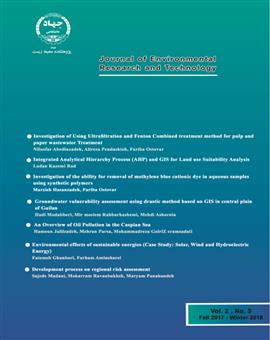Investigation of the ability for removal of methylene blue cationic dye in aqueous samples using synthetic polymers
Subject Areas : Water and wastewater technology
Marzieh Hasanzadeh
1
,
Fariba Ostovar
2
![]()
1 -
2 - Faculty member of Environmental Research Institute of ACECR
Keywords: Polypyrrole Adsorption Poly (3-methylthiophene) Surfactant modified absorbent Isotherm,
Abstract :
In this research, the ability for removal of methylene blue cationic dye using Electro active polymers based on polypyrrole (PPy) and poly (3-methylthiophene) (P3MTh) in a batch system were studied. Sawdust (SD) was made from wood, after patching, as a holder for coating polymers and Sodium Dodecyl Sulfate Anionic Surfactant (SDS) was used to modify the surface of the sawdust. The effects of some important parameters such as pH, initial concentration of dye and contact time were investigated. To evaluate the obtained data, adsorption isotherm curves (Langmuir and Freundlich) were used. The adsorption efficiency for methylene blue was maximized at alkaline pH. Adsorption capacity increased with increasing initial concentration and contact time. In all cases, the adsorption process complies with Langmuir isotherm and represents the homogeneous and single-layer process. Also, the adsorption capacity obtained in SD/PPy, SD /PPy / SDS and SD / P3MTh polymers were 59/52, 400 and 1000 mg/g, respectively. Based on the studies and the results obtained in this study, it was found that these polymer materials can effectively be used in waste dyes, such as textile industry, which they have the great environmental significance.
1. Bhatnagar A, Jain A.K. A comparative adsorption study with different industrial wastes as adsorbents for the removal of cationic dyes from water. Journal of Colloid and Interface Science. 2005;281(1):49-55.
2. Hameed B.H. Evaluation of papaya seeds as a novel non-conventional low-cost adsorbent for removal of methylene blue. Journal of Hazardous materials. 2009;162(2):939-944.
3. Salehi M. Hashemipour H. Mirzaee M. Experimental study of influencing factors and kinetics in catalytic removal of methylene blue with TiO2 nanopowder. American journal of environmental engineering. 2012;2(1):1-7.
4. Gupta V.K. Pathania D. Agarwal S. Singh P. Preparation of cellulose acetate-zirconium (IV) phosphate nanocomposite with ion exchange capacity and enhanced photocatalytic activity. J Hazard Mater. 2012;243:179-186.
5. Lee J.W. Choi S.P. Thiruvenkatachari R. Shim W.G. Moon H. Evaluation of the performance of adsorption and coagulation processes for the maximum removal of reactive dyes. Dyes and pigments. 2006;69(3):196-203.
6. Dąbrowski A. Adsorption—from theory to practice. Advances in colloid and interface science. 2001;93(1):135-224.
7. Robinson T. McMullan G. Marchant R. Nigam P. Remediation of dyes in textile effluent: a critical review on current treatment technologies with a proposed alternative. Bioresource technology. 2001; 77(3): 247-255.
8. Ray S.S. Okamoto M. Polymer/layered silicate nanocomposites: a review from preparation to processing. Progress in polymer science, 2003;28(11):1539-1641.
9. Ansari R. Delavar A.F. Application of poly 3‐methylthiophene for removal of silver ion from aqueous solutions. Journal of applied polymer science. 2009;113(4):2293-2300.
10. Ansari R. Mosayebzadeh Z. Application of polyaniline as an efficient and novel adsorbent for azo dyes removal from textile wastewaters. Chemical Papers. 2011;65(1):1-8.
11. Gupta V.K. Pathania D. Singh P. Kumar A. Rathore B.S. Adsorptional removal of methylene blue by guar gum–cerium (IV) tungstate hybrid cationic exchanger. Carbohydrate polymers. 2014;101:684-691.
12. Inbaraj B.S. Chiu C.P. Ho G.H. Yang J. Chen B.H. Removal of cationic dyes from aqueous solution using an anionic poly-γ-glutamic acid-based adsorbent. Journal of hazardous materials. 2006;137(1):226-234.
13. Huang C.H. Chang K.P. Ou H.D. Chiang Y.C. Wang C.F. Adsorption of cationic dyes onto mesoporous silica. Microporous and Mesoporous Materials. 141(1):102-109. 2011.
14. Babaei Zarch HR. Ganjidoust H. Ayati B. Lead Removal from Wastewater by Adsorption using Ash and Sawdust. Modares Civil Engineering Journal, 13(2):17-26. 2013.
15. Mellah A. Chegrouche S. Barkat M. The removal of uranium (VI) from aqueous solutions onto activated carbon: kinetic and thermodynamic investigations. Journal of colloid and interface science.296(2):434-441.2006.


